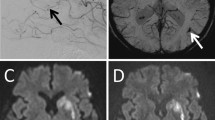Summary
Space-occupying middle cerebral artery (MCA) infarction is characterized by massive brain edema associated with deterioration of consciousness. Progressive brainstem function occurs finally leading to death as a result of transtentorial herniation. We analyzed whether acute stroke MRI with perfusion weighted imaging (PWI), diffusion weighted imaging (DWI) and MR angiography (MRA) allows the prediction of space-occupying MCA stroke in patients with proximal brain vessel occlusion (MCA main stem, carotid-T).
Thirty-seven patients with acute MCA stroke and proximal vessel occlusion were studied by PWI, DWI and MRA within 6 hours of symptom onset. Eleven patients developed space-occupying MCA infarction. The DWI lesion was defined by a reduction of the apparent diffusion coefficient (ADC) of less than 80% (ADC<80%) compared with the unaffected hemisphere. The PWI lesion was defined as a time to peak (TTP) delay of more than 4 seconds (TTP>+4 s), respectively. Neurological deficit was assessed using the National Institutes of Health Stroke Scale (NIHSS). Outcome was assessed 90 days after stroke with the Barthel Index (BI) and the modified Rankin Scale (MRS).
Patients with space-occupying MCA infarction showed larger diffusion- and perfusion lesion volumes (median ADC<80%: 157 vs 22 ml, p<0.001; TTP>+4 s: 208 vs 125 ml), a higher frequency of carotid-T occlusion (64 vs 15%, p=0.006) and higher NIHSS scores at admission (20 vs 15, p=0.001). Clinical outcome was worse in patients with space-occupying MCA infarction (MRS: 4 vs 1, p<0.001; BI: 13 vs 100, p=0.001). The following parameters served as predictors of space-occupying MCA infarction (sensitivity, specificity): ADC<80% >82 ml (87%, 91%), TTP>+4 s >162 ml (83%, 75%), NIHSS score at admission ≥19 (96%, 72%).
Stroke MRI with the combination of PWI, DWI and MRA allows the prediction of space-occupying MCA stroke within the 6-hour time window and can help select patients for aggressive and potentially life-saving therapies such as decompressive hemicraniectomy.
Zusammenfassung
Der raumfordernde Mediainfarkt ist gekennzeichnet durch die Entwicklung eines massiven Hirnödems, welches mit sekundärer Bewusstseinseintrübung einhergeht. Es kommt zum zunehmenden Verlust von Hirnstammfunktionen bis hin zum Tod infolge transtentorieller Einklemmung. Wir haben untersucht, ob das akute Schlaganfall-MRT mit perfusions- und diffusionsgewichteter Bildgebung (PWI und DWI) und MR-Angiographie (MRA) die Vorhersage eines raumfordernden Mediainfarktes bei Patienten mit proximalem Gefäßverschluss (Media-Hauptstamm, Carotis-T) ermöglicht.
Siebenunddreißig Patienten mit akutem Mediainfarkt und proximalem Gefäßverschluss wurden innerhalb von 6 h nach Symptombeginn mit PWI, DWI und MRA untersucht. Im Verlauf entwickelten 11 Patienten einen raumfordernden Mediainfarkt. Die Diffusionsläsion wurde definiert als Areal mit einer Verminderung des apparent diffusion coefficient (ADC) auf weniger als 80% (ADC<80%), die Perfusionsläsion als Bereich mit einer Verzögerung der time to peak (TTP) um mehr als 4 s (TTP>+4 s) im Vergleich zur nicht betroffenen Hemisphäre. Das neurologische Defizit bei Aufnahme wurde anhand der National Institutes of Health Stroke Scale (NIHSS) eingeschätzt. Das neurologische Outcome wurde 90 Tage nach Ereignis mittels Barthel-Index (BI) und modified Rankin-Scale (MRS) eingeschätzt.
Patienten mit raumforderndem Mediainfarkt zeigten größere Diffusions- und Perfusionsläsionen (median ADC<80%: 157 vs. 22 ml, p<0,001; TTP>+4 s: 208 vs. 125 ml), häufiger einen Verschluss im Carotis-T (64 vs. 15%, p=0,006) und waren bei Aufnahme klinisch schwerer betroffen (NIHSS 20 vs. 15, p=0,001). Das klinische Outcome war schlechter bei Patienten mit raumforderndem Mediainfarkt (MRS: 4 vs. 1, p<0,001; BI: 13 vs. 100, p=0,001). Die besten Prädiktoren für die Entwicklung einer malignen Raumforderung waren: ADC<80% >82 ml (Sensitivität 87%, Spezifität 91%), TTP>+4 s >162 ml (83%, 75%), NIHSS-Score bei Aufnahme ≥19 (96%, 72%).
Das Schlaganfall-MRT mit PWI, DWI und MRA im 6-Stunden-Zeitfenster ermöglicht eine zuverlässige Vorhersage der Entwicklung eines raumfordernden Mediainfarkts und hilft bei der Indikationsstellung aggressiver und potentiell lebensrettender Maßnahmen wie z.B. der dekompressiven Hemikraniektomie.
Similar content being viewed by others
Author information
Authors and Affiliations
Corresponding author
Rights and permissions
About this article
Cite this article
Thomalla, G., Kucinski, T., Fiehler, J. et al. Das akute Schlaganfall-MRT mit perfusions- und diffusionsgewichteter Bildgebung in der Diagnostik des raumfordernden Mediainfarktes. Intensivmed 41, 227–237 (2004). https://doi.org/10.1007/s00390-004-0473-9
Received:
Accepted:
Issue Date:
DOI: https://doi.org/10.1007/s00390-004-0473-9
Key words
- Acute stroke
- brain edema
- magnetic resonance imaging
- perfusion weighted imaging
- diffusion weighted imaging




